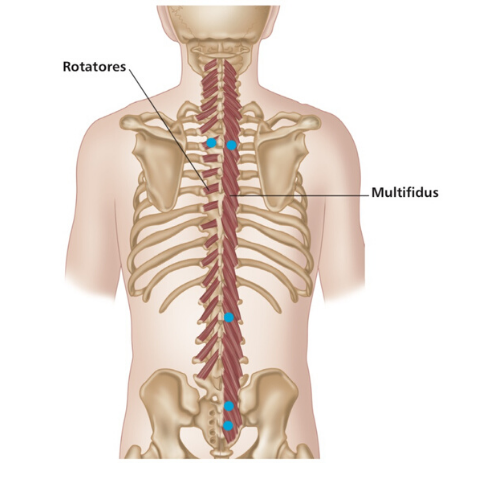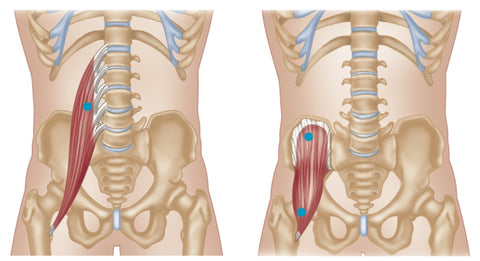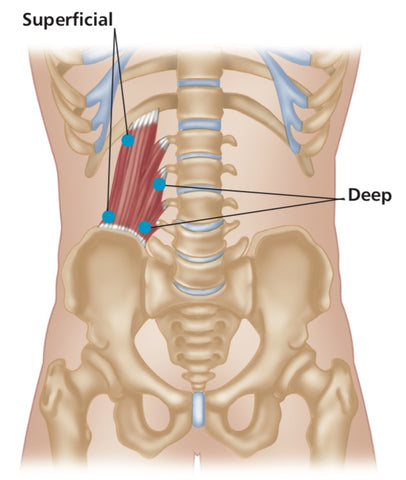Lower Back Pain - An Overview of the Key Muscles Involved

Lower back pain is often associated with myofascial trigger points
In reality, these kinds of problems are often just minor factors in back pain. In fact, most acute and chronic back pain may be associated with trigger points.
The body tends to shut down around pain to avoid further noxious stimuli. Part of the way it does this is by using trigger points.
Depending on how long the symptoms have persisted, we see certain “classic” trigger points when dealing with Lower back Pain (LBP).
For example - the erector spinae, multifidus, iliopsoas, quadratus lumborum, piriformis, rectus abdominus and hamstring muscles tend to manifest trigger points in patients with disc problems, whilst the gluteus medius muscle ‘switches-off’ by developing trigger points in response to sacroiliac problems.
Treating Trigger Points - Paul Townley PT
Multifidus
The multifidus muscle has a deeper and more superficial arrangement and is intimately involved with most types of LBP and often manifests trigger points.
Because the muscles are so deep you need to use firm pressure to work on these trigger points.
Pain is typically reported at the spinous processes of L1–L5 and anterior to the abdomen. S1 projects pain down to the coccyx; this referral radiates laterally from the level of T4–T5 to the inferior angle of the scapula.
Trigger points located in the cervical region of the multifidus refer pain from the suboccipital region, down the posterior neck to the approximate segmental level of T3 and laterally to the rhomboids.
There is also often referred pain to the base of the neck and upper back region.

Common Multifidi / Rotatores Trigger Points
Erector Spinae
Interestingly and contrary to what some of us have been taught, the erector spinae don’t hold the spine erect! Most fibers are in fact electrically silent during postural work (Kippers, 1984). This muscle group is designed to activate during extension from flexion, i.e. standing upright from bending forward.
The erector spinae has three divisions each of which may manifest a trigger point.
According to Travell and Simons, individual pain patterns of several trigger points that refer pain to the Lumbosacral region may blend into each other.

Common Erector Spinae Trigger Points
Piriformis
The piriformis eccentrically contracts to decelerate internal rotation and hip adduction when the hip is flexed.
A short piriformis can cause the sacrum to tilt, giving the appearance of a short-leg discrepancy, and result in a rotation or twisting of the sacrum in the sacroiliac joint, setting up additional sacroiliac stress. (Note: If not corrected in a timely fashion, this is a recipe for shoulder injury).
Piriformis often gets involved with the protective "holding" patterns. It has been suggested that when the piriformis muscle gets tight, it can compress the sciatic nerve, or even the blood vessels to the nerve (vaso nervorum) which can lead to (pseudo) sciatica.
Remember that around 17% of people have a sciatic nerve that runs through the piriformis muscle.
Rectus Abdominus
The rectus abdominis has two distinct pain patterns: one at the level of the xiphoid process, spreading bilaterally across the middle back, and the other at the level between the umbilicus and the inguinal ligament, spreading pain into the sacroiliac joint and lower back.
Note that rectus abdominis trigger points can also cause chest pain, heartburn, belching, diarrhea, and dysmenorrhea.
Psoas / Iliacus
The iliacus and psoas major (including the psoas minor if one is evident) work together to provide a deceleration of internal rotation of the femur on heel-strike and slow hip extension.
Bilateral contraction of this fleshy triangular muscle provides stability to the lumbar spine. These muscles are rich in muscle spindles and are therefore prone to shorten under stress. This in turn can cause inhibition in the gluteus maximus.
Prolonged sitting has been identified as a significant precursor to the formation of trigger points. Trigger points form in the psoas major as a result of primary trigger points in related muscles of the psoas functional unit.
These muscles include the rectus femoris, pectineus, sartorius, tensor fascia latae, adductors (longus, brevis, magnus), and gracilis.
Pain is typically felt as a vertical pattern ipsilaterally along the lumbar spine, and downward over the sacroiliac joint and gluteal region.

Psoas Major (Left) and Iliacus (Right) Trigger Points
Gluteus Maximus
The gluteus maximus plays a significant role in stabilizing both the sacroiliac joint and the knee joint. It does so by means of superior fibers, which attach to the aponeurosis of the sacrotuberous ligament, and inferior fibers, which attach anteriorly to the iliotibial band, providing tension down to the knee.
It is hypothesized that gluteal trigger points could be a result of inhibition in the gluteal muscles caused by spasm in the psoas muscles, gluteus medius, and gluteus minimus. The formation of these trigger points provides much-needed tension for sacroiliac support.
Pain is often felt in the lower back and mimics bursitis of the hip, with pain experienced at the site of the coccygeal bone and of the gluteal crease.
Gluteus Medius
This muscle is a major generator of lower back and hip pain, as well as being responsible for complaints of a burning sensation along the posterior superior iliac spine (PSIS) and sacroiliac joint.
Pain is often mistaken for lumbago- type pain, with discomfort (such as tenderness) into the buttocks and superior thigh.
Hamstrings
Typically, pain is referred up toward the gluteal muscles, with some residual pain spreading down just below and behind the knee into the medial gaster of
the gastrocnemius. This pain can also often be mistaken for sciatic pain.
Weak inhibited gluteal muscles, including the gluteus medius, can lead to trigger points forming in the hamstrings and lumbar erector muscles, including the quadratus lumborum.
Ultimately, the hamstrings are trying to be gluteal muscles, while the lumbar muscles are trying to be hamstrings.
Quadratus Lumborum (Q/L)
A short quadratus lumborum leads to a functional short leg on the same side. This in turn leads to muscle adaptations, whereby the contralateral adductors may shorten in an effort to pull the femur more posteriorly into the acetabulum.
This can create the look of a short leg on the contralateral side and cause subluxation at the pubic symphysis and sacroiliac joint.
Pain from QL trigger points is experienced at the sacroiliac joint and into the gluteal muscles and the hip. Referred pain in the anterior thigh and groin can be very painful. Fear of coughing or sneezing because of intolerable pain in the lower back is common.

Common Quadratus Lumborum (QL) Trigger Points
Levator Ani
The levator ani muscle consists of the pubococcygeus and the iliococcygeus muscles. Together with the coccygeus muscle, these muscles form the pelvic diaphragm (the muscular floor of the pelvis).
Trigger points in the levator ani muscle can be implicated in low back pain syndromes.
Soleus
From a dynamic postural viewpoint, the soleus prevents the body falling forward at the ankle joint during standing.
In gait, the muscle eccentrically decelerates subtalar joint pronation and internal rotation of the lower leg at heel-strike. It also decelerates dorsi flexion of the foot.
Surprisingly to many, trigger points in the soleus can be the origin of tight hamstrings and lower back pain.
Links
Back Pain - Trigger Point Release
Dry Needling for Trigger Points
Certify as a Trigger Point Therapist
About NAT Courses
As a manual therapist or exercise professional, there is only one way to expand your business - education!
Learning more skills increases the services that you offer and provides more opportunity for specialization.
Every NAT course is designed to build on what you already know, to empower you to treat more clients and grow your practice, with a minimal investment in time and money.
Help Desk
About Niel Asher Education
Niel Asher Education is a leading provider of distance learning and continued education courses.
Established in the United Kingdom in 1999, we provide course and distance learning material for therapists and other healthcare professionals in over 40 countries.
Our courses are accredited by over 90 professional associations and national accreditation institutions including the National Academy of Sports Medicine (NASM) and National Certification Board for Therapeutic Massage and Bodywork (NCBTMB). Full details of all international course accreditations can be found on our website.
Printed course materials and other products offered on our websites are despatched worldwide from our 3 locations in the UK (London), USA (Pennsylvania) and Australia (Melbourne).
More About Us
NAMTPT AWARD
We are honored to have received the "Excellence in Education" Award from the National Association of Myofascial Trigger Point Therapists.
Since 1999 Niel Asher Education has won numerous awards for education and in particular for education and services provided in the field of trigger point therapy.
Read Full Article
Award Winning Instructors
Niel Asher Healthcare course instructors have won a host of prestigious awards including 2 lifetime achievement honorees - Stuart Hinds, Lifetime Achievement Honoree, AAMT, 2015, and Dr. Jonathan Kuttner, MD, Lifetime Achievement Honoree, NAMTPT, 2014.
Meet the Instructors
Accreditation

If you are a qualified/licensed manual therapist or exercise/fitness professional you can expand your credentials with NAT certification.
In addition to national accreditation for continued education, each course that we offer includes "NAT Learning Credits". By taking and completing courses you can accumulate NAT credits to qualify for NAT certification.
There are currently 3 levels of NAT certification. Certifying NAT is a valuable way to show your clients that you take continued education seriously, and to promote your skills and qualifications.
Most of our courses are accredited for CE/CPD/CPE. A full list of CE accreditations can be found by clicking on the link below.
About NAT Certification
Niel Asher Technique
Since 1999 the Niel Asher Technique for treating trigger points has been adopted by over 100,000 therapists worldwide, and has been applied to the treatment of a number of common musculoskeletal injuries.
The Niel Asher Technique for treating frozen shoulder was first introduced and published in 1997 and has been widely adopted by therapists and exercise professionals working within elite sports and athletics.
Read More
International Students
Most of our courses are available as either "Printed" or 'Download" editions, wherever you live. Internet connection is required to access online and downloadable material.
When you purchase a download edition, you receive immediate lifetime access to all course material. Course texts can be downloaded and printed if required.
When you purchase a "Printed" edition, you will also receive free access to the download edition.
We ship Worldwide from locations in the USA, UK, and Australia. Most items are despatched within 24 hours and shipping is FREE for all orders over US$50.
Shipping
Where to Start?
We offer a range of over 50 courses, presented by some of the worlds leading manual therapists. All courses are reviewed annually, and new courses are regularly added.
Our courses are modular, and designed to build on what you already know. For more information, please visit our "Where to Start?" page.
Start Here

Trigger Point Therapy Diploma Course

EDUCATION MEMBERSHIP PLANS
UNLIMITED ACCESS
FROM $19.95/monthly
About Niel Asher Education
Niel Asher Education (NAT Global Campus) is a globally recognised provider of high-quality professional learning for hands-on health and movement practitioners. Through an extensive catalogue of expert-led online courses, NAT delivers continuing education for massage therapists, supporting both newly qualified and highly experienced professionals with practical, clinically relevant training designed for real-world practice.
Beyond massage therapy, Niel Asher Education offers comprehensive continuing education for physical therapists, continuing education for athletic trainers, continuing education for chiropractors, and continuing education for rehabilitation professionals working across a wide range of clinical, sports, and wellness environments. Courses span manual therapy, movement, rehabilitation, pain management, integrative therapies, and practitioner self-care, with content presented by respected educators and clinicians from around the world.
Known for its high production values and practitioner-focused approach, Niel Asher Education emphasises clarity, practical application, and professional integrity. Its online learning model allows practitioners to study at their own pace while earning recognised certificates and maintaining ongoing professional development requirements, making continuing education accessible regardless of location or schedule.
Through partnerships with leading educational platforms and organisations worldwide, Niel Asher Education continues to expand access to trusted, high-quality continuing education for massage therapists, continuing education for physical therapists, continuing education for athletic trainers, continuing education for chiropractors, and continuing education for rehabilitation professionals, supporting lifelong learning and professional excellence across the global therapy community.

Continuing Professional Education
Looking for Massage Therapy CEUs, PT and ATC continuing education, chiropractic CE, or advanced manual therapy training? Explore our evidence-based online courses designed for hands-on professionals.


















